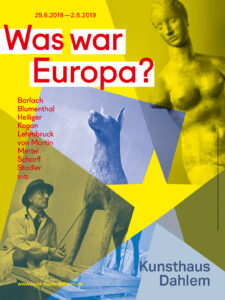29.06.2018 –
02.06.2019
What Was Europe?

In 1950 the exhibition »Werke europäischer Plastik« (Works of European Sculpture) opened at the Haus der Kunst in Munich. It represented the first attempt after 1945 of German sculptors to compare themselves directly to Western European modernism. The organizers—the four sculptors and professors of the Munich academy Toni Stadler, Georg Brenninger, Josef Wackerle, and Theodor Georgii—self-confidently noted in the introduction to the exhibition catalog: »May the selected sculptures from a wide variety of regions of the plastic imagination not confront one another in a hostile way but rather reveal through their quality an inner relationship.«
More than 70 works by 35 German and eleven French, British, Italian, and Swiss artists were on view in this first European show after the war, among them by prominent representatives of their field such as Henry Moore and Aristide Maillol. Thus, German sculpture was decidedly put side by side with the most renowned sculptors of Western European Modernism.
The exhibition »What Was Europe?« gathers once again then exhibited works—to the extent they could be identified and were available for loan. The exhibition shows where the young Federal Republic of Germany from the perspective of sculptors in Munich located itself in the international and Western European context. »What Was Europe?« concentrates on the German artists, all of whom—in keeping with the selection made by the organizers of the Munich exhibition at the time—can be placed in the figurative tradition of sculpture. Whereas in Berlin during this same period an abstracting or abstract modernism was gaining recognition (as been manifested in the works of the Berlin sculptor Bernhard Heiliger, who is exhibited in the adjacent room), artists in Southern Germany preferred a figurative tradition what found expression in an intense engagement with the human body but also with sculptures of animals.
Whereas in 1950 there was a decided accent on an apolitical gesture by bringing together national and international sculpture, today the associated exclusion of the immediate past as well as the participation of individual artists who had also taken part in the art world of the National Socialist regime reads as highly problematic. At the Kunsthaus Dahlem, in an architectural framework similar to that of the Haus der Kunst, the presentation is now considered in terms of its political imposition as well.